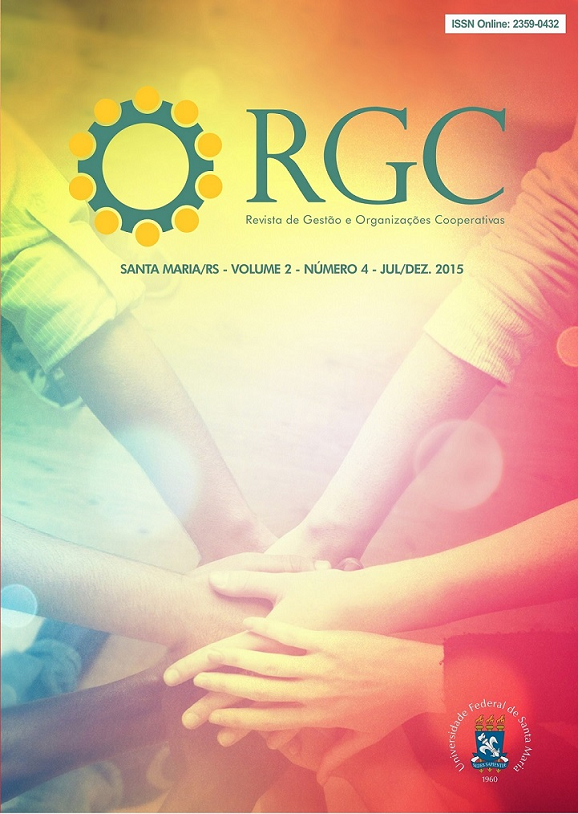Adding value and distribution of value added to farmers: the case of a cooperative of coffee growers
DOI:
https://doi.org/10.5902/2359043221234Keywords:
Cooperatives, value added, associated farmersAbstract
This paper aims to investigate what is the value added and distribution of agricultural cooperatives. For the cooperative fulfill its function to generate value and distribution is required. Therefore, analyzing the performance of a cooperative only through the traditional model of performance evaluation of the organizations may not be the most suitable as it takes into consideration the profit. One way to analyze the economic and social performance of organizations occurs through the value generated, which is the economic value that is added to the goods and services. The methodology consists of a case study, which analyzed the Management Reports and Value Added Statement for a coffee cooperative, analyzing 3 years, 2010 to 2012. The results confirm the distribution of value generated by the cooperative studied, resulting in an average value of benefits by associate, in 2012, of R $ 8,166.69.Downloads
References
ALIANÇA COOPERATIVA INTERNACIONAL (International Cooperative Alliance [ICA]. (2015). What is a Co-operative? Disponível em: <http://ica.coop/en/what-co-operative>. Acesso em: 13/01/2016.
BIALOSKORSKI NETO, Sigismundo. Economia e Gestão de Organizações Cooperativas. 2. ed. São Paulo: Atlas, 2012.
______; NAGANO, Marcelo Seido; MORAES, Marcelo Botelho da Costa. Utilização de redes neurais artificiais para avaliação sócio-econômica: uma aplicação em cooperativas. Revista de Administração (USP), São Paulo, v. 41, n. 1, p. 59-68, 2006.
______; PINTO, Anelise Krauspennhar. Evolução do Agronegócio e do Cooperativismo Agropecuário: uma análise comparativa de desempenho e impacto econômico. In: ENCONTRO BRASILEIRO DE PESQUISADORES EM COOPERATIVISMO, 2, 2012, Porto Alegre. Anais... Porto Alegre, 2012.
CANÇADO, Airton Cardoso; SOUZA, Maria de Fátima Arruda; CARVALHO, Jacqueline Elisa Furtado Barreto de; IWAMOTO, Helga Midori. Desfazendo um mal entendido: Discutindo a diferença entre lucros e sobras. Administração Pública e Gestão Social. Viçosa, v. 5, n. 1, p. 56-69, 2013.
CONSOLI, Matheus Alberto; MARINO, Matheus Kfouri. Distribuidores e Cooperativas: análises e impressões (parte 2). 2013. Disponível em: <http://www.agrodistribuidor.com.br/up_arqs/ pub_20130408152754_08deabril.pdf > Acesso em: 20/07/2013.
DALMÁCIO, Flávia Zóboli. Indicadores para Análise da Demonstração do Valor Adicionado. Revista Brasileira de Contabilidade, Brasília, DF, v. 1, n.1, p. 89-97, 2004.
DE LUCA, Márcia Martins Mendes. Demonstração do Valor Adicionado: do cálculo da riqueza criada pela empresa ao valor do PIB. São Paulo: Atlas, 1998.
FERREIRA, Marco Aurélio Marques; BRAGA, Marcelo José. Diversificação e Competitividade nas Cooperativas Agropecuárias. Revista de Administração Contemporânea, vol.8, n.4, p. 33-55, 2004.
GIL, Antonio Carlos. Como elaborar projetos de pesquisa. São Paulo: Atlas, 1999.
INSTITUTO BRASILEIRO DE GEOGRAFIA E ESTATÍSTICA – IBGE. Série Relatórios Metodológicos. Brasil, 2. ed., vol. 24, 2008. Disponível em: <http://www.ibge.gov.br/home/estatistica/ economia/contasnacionais/2008/SRM_contasnacionais.pdf>. Acesso em: 23/07/2013.
KROETZ, César Eduardo; COSENZA, José Paulo. Considerações sobre a eficácia do valor adicionado para a mensuração do resultado econômico e social. In: IX Convenção de Contabilidade do Rio Grande do Sul, 2003, Gramado, RS. Anais.
LAUREANO, Wagner Deodato. Analisando a demonstração do valor adicionado. Revista Brasileira de Contabilidade, Brasília, n. 122, p. 38-43, mar./abr. 2000.
MANDAL, Niranjan; GOSWAMI, Suvarun. Value Added Statement (VAS) – A critical analysis. Great Lakes Gerald. Chennai, v. 2, n. 2, p. 98-120, 2008.
MAGALHÃES, Luzia Eliana Reis; ORQUIZA, Liliam Maria. Metodologia do trabalho científico: elaboração de trabalhos. Curitiba: Fesp, 2002.
MATTAR, Fauze Najib. Pesquisa de marketing: metodologia, planejamento. São Paulo: Atlas, 1999.
ORGANIZAÇÃO DAS COOPERATIVAS NO BRASIL –OCB. (2015). [online] Disponível em: <http://www.brasilcooperativo.coop.br/site>Acesso em: 10/01/2015.
PRESNO, Nora. As cooperativas e os desafios da competitividade. Estudos Sociedade e Agricultura, Rio de Janeiro, 2001, p. 119-144. Disponível em: <http://r1.ufrrj.br/esa/art/200110-119-144.pdf>. Acesso em: 05/07/2013.
SANTOS, Ariovaldo dos. Demonstração do Valor Adicionado: como elaborar e analisar a DVA. São Paulo: Atlas, 2003.
SEXTON, Richard J. Cooperatives and the forces shaping agricultural marketing. American Journal of Agricultural Economics. Menasha, vol. 68, n. 5, p. 1167-1172, 1986.
TINOCO, João Eduardo Prudêncio. Balanço Social: uma abordagem de transparência e da responsabilidade pública das organizações. 3. ed. São Paulo: Atlas, 2006.
VIEIRA, Patrícia dos Santos; SANTOS, Ariovaldo dos. Um estudo empírico sobre a carga tributária das sociedades cooperativas agropecuárias a partir da demonstração do valor adicionado. In: Congresso USP de Controladoria e Contabilidade. 7, 2007, São Paulo.
ZYLBERSTAJN, Décio. Administração de sistemas de base agrícola: análise de fatores críticos. Revista de Administração. São Paulo, vol. 48, n. 2, p. 203-207, 2013.
Downloads
Published
How to Cite
Issue
Section
License
Authors who publish in this journal agree to the following terms:
- Authors retain copyright and grant the journal the right of first publication, with work simultaneously licensed under the Creative Commons Attribution License that allows the sharing of work with acknowledgment of authorship and initial publication in this journal.
- Authors are authorized to enter additional contracts separately for non-exclusive distribution of the version of the work published in this journal (eg, publishing in institutional repository or as a book chapter), with acknowledgment of authorship and initial publication in this journal.
- Authors are allowed and encouraged to post and distribute their work online (eg, in institutional repositories or on their personal page) at any point before or during the editorial process, as this can bring about productive change as well as increase impact and impact. citation of published work (See The Effect of Free Access).







